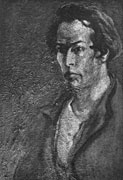
Santiago Stagnaro was born in Montevideo, Uruguay, on April 23, 1888. He was brother to the sculptor Orlando Stagnaro. He moves to La Boca and works as an educator, journalist, musician and poet. He also does some sculpturing and painting and becomes an active anarchist.
He befriends Juan de Dios Filiberto and Benito Quinquela Martín, artists who, during their own humble youthful days, helped Stagnaro with financial support.
In 1910, he takes part in an exhibition held to celebrate the 25 years of Sociedad Ligure de mutuo Socorro. He attends the Salón Nacional in various occasions. As secretary of the Boilermakers Society, together with a group of co-workers, he is able to obtain an 8-hour work day. In the words of Bucich, “an esthete [...] an agitator [...] he took on an influential role in the blue collar life of the La Boca del Riachuelo”
Stagnaro becomes director of the La Opinión newspaper and collaborates with different publications of his time such as the science and art magazine Azul. He also teaches at the Escuela "Fray Justo Santa María de Oro" and is the first president of the Sociedad Argentina de Artistas Plásticos - SAAP, founded in 1917.
He dies in Buenos Aires on February 14, 1918, a little before turning 30 years old. This same year, an exhibition is held at the Galería Costa. In 1920, the Museo Nacional de Bellas Artes organizes an exhibit with his work.
Between 1952 and 1953, his work is shown at the exhibition of La Pintura y Escultura Argentina del Siglo XX. On July 18,1954, the newspaper of the city of Rosario, La Tribuna, writes a long article about the acquisition of Stagnaro’s work titled Fantasía, a gouache that his brother Orlando donates to the Museo Municipal de Bellas Artes “Juan B. Castagnino” of that city. The full page article includes details of the “torturous life of the Stagnaro family”, in the words of Orlando:
“[...] we lived in the heavily populated neighborhood of La Boca, on 375 Zárate street (today Carlos F. Melo), our family was made up of my mother, two brothers and three sisters. We had lost our father when I wasn’t even a year old [...] a close friend of my brother’s, [...] Benito Quinquela Martín, gave me small packages of mate tea, sugar, noodles and other food which would help complete our small daily rations [...] we lived in the strictest poverty, and Santiago, nine years older than I, already showed signs of his passion for the arts [...]”
His work can be found at the Museo Nacional de Bellas Artes de Buenos Aires; the Escuela-Museo “Don Pedro de Mendoza” in La Boca; the now extinct Museo Municipal de Lomas de Zamora - part of its patrimony belongs to the Museo Pío Collivadino in Banfield and Museo Americanista in Lomas de Zamora. The provincial museums of Bellas Artes in Córdoba and Santa Fe also house some of his work.